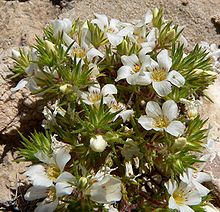Linanthus
| Linanthus | |
|---|---|

| |
| Linanthus demissus | |
| Scientific classification | |
| Kingdom: | Plantae |
| Clade: | Tracheophytes |
| Clade: | Angiosperms |
| Clade: | Eudicots |
| Clade: | Asterids |
| Order: | Ericales |
| Family: | Polemoniaceae |
| Genus: | Linanthus Benth. |
| Species | |
|
about 15, see text | |
Linanthus is a genus of annual and perennial plants in the phlox family Polemoniaceae. The species are found in western North America and in Chile, with the greatest diversity in California.
The stems are erect, with multiple branches arising directly from the base, and grow 2–15 cm tall. The leaves are stem-like (cauline) and opposite, with shapes ranging from entire to palmately lobed, the 3-9 lobes being linear to lanceolate or spatulate. Flowers have a tubular calyx, and the corolla may be funnel- or bell-shaped, or salverform.
The genus name is from the Greek for "flax flower", the flowers superficially resembling those of flax.
The genus has recently been split, with many of the species formerly included now transferred to the genus Leptosiphon (Jepson Manual).
- Selected species
- Linanthus bellus (Gray) Greene
- Linanthus bigelovii (A. Gray) Greene
- Linanthus concinnus Milliken
- Linanthus demissus (A. Gray) Greene
- Linanthus dianthiflorus (Benth.) Greene
- Linanthus dichotomus Benth.
- Linanthus filiformis (Parry ex A. Gray) J.M. Porter & L.A. Johnson
- Linanthus inyoensis (I.M.Johnst.) J.M.Porter & L.A.Johnson
- Linanthus jonesii (A. Gray) Greene
- Linanthus killipii H. Mason
- Linanthus maculatus (Parish) Milliken
- Linanthus orcuttii (Parry & A. Gray) Jeps.
- Linanthus parryae (A. Gray) Greene
- Linanthus pungens (Torr.) J.M. Porter & L.A. Johnson
- Linanthus watsonii (A. Gray) J.M. Porter & L.A. Johnson
- Species formerly treated in Linanthus, now transferred to Leptosiphon
- Leptosiphon acicularis
- Leptosiphon ambiguus
- Leptosiphon androsaceus
- Leptosiphon arenicola
- Leptosiphon aureus
- Leptosiphon bicolor
- Leptosiphon bolanderi
- Leptosiphon breviculus
- Leptosiphon ciliatus
- Leptosiphon filipes
- Leptosiphon floribundus
- Leptosiphon grandiflorus
- Leptosiphon harknessii
- Leptosiphon lemmonii
- Leptosiphon liniflorus
- Leptosiphon montanus
- Leptosiphon nudatus
- Leptosiphon nuttallii
- Leptosiphon oblanceolatus
- Leptosiphon pachyphyllus
- Leptosiphon parviflorus
- Leptosiphon pygmaeus
- Leptosiphon rattanii
- Leptosiphon septentrionalis
- Leptosiphon serrulatus
References
- Jepson Manual: Linanthus
- Robert W. Patterson (1977) Madroño 24: 36–48
